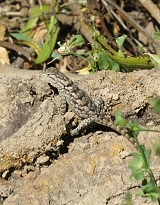Clark's Spiny Lizard (Sceloporus clarkii)
Description: These are medium to large lizards with snout-vent lengths ranging from 2¼ to 5¼ inches. These robust lizards have keeled, pointed scales. Background color is usually subdued gray, tan, or blue with a striking wide, purple stripe down the back and single yellow scales scattered on the sides (S. magister), or scattered turquoise scales mixed with tan and brown on the back and sides (S. clarkii). Both species have a dark collar under or around the neck; males have vivid blue throats and under-bellies. Females develop orange to red heads during the breeding season. The presence of distinct cross bands on the forlimbs is a usefull feature for distinguishing the species from Desert Spiny Lizard Sceloporus magister, a vaguely similar animal that is quite abundanrt in the region.
Habitat: This lizard occurs primarily in wooded habitats of lower mountain: oak-pine woodland, tropical deciduous forest, subtropical thornforest, riparian woodland communities that penetrate into more arid landscapes from forested mountains; it also inhabits rocky areas at the lower edges of foothills and in oak-grassland communities as low as 1,060 meters. It is primarily a tree-dweller (climbs high into trees) but also can be found on the ground among rocks. Woodrat nests in trees may be used as refuges.
Range: The range encompasses central and southeastern Arizona (and disjunctly southwestern and northwestern Arizona) and southwestern New Mexico and extends southward to northern Jalisco, Mexico, including Islas Tiburon and San Pedro Nolasco in the Gulf of California. Elevational range extends from sea level to about 6,060 feet
Found in these States:
AZ |
NM
Diet: Feeds on insects, occasionally leaves, buds and flowers.
Reproduction: Central Arizona: eggs laid June to mid-July; most females produce 1 clutch annually, some lay second clutch in July; clutch size averages 20; females sexually mature in 22 months
Status: Listed as Least Concern in view of the relatively large and stable extent of occurrence, area of occupancy, number of subpopulations, and population size. No major threats have been identified.
Subspecies: Three, with 2 in our region
Southern Clark’s Lizard - (Sceloporus clarkii boulengeri) (not in our region)
Sonoran Spiny Lizard - (Sceloporus clarkii clarkii)
Plateau Spiny Lizard - (Sceloporus clarkii vallaris)
»» Kingdom: Animalia - Animals
»» Phylum: Chordata - Chordates
»» Subphylum: Vertebrata - Vertebrates
»» Class: Reptilia - Reptiles
»» Order: Squamata - Lizards
»» Family: Phrynosomatidae - North American Spiny Lizards
»» Genus: Sceloporus
»» Species: Sceloporus clarkii
- Clark's Spiny Lizard
»» Subspecies:
»»
Sceloporus clarkii clarkii - Sonoran Spiny Lizard
»»
Sceloporus clarkii vallaris - Plateau Spiny Lizard
This article uses material from the Wikipedia article "Sceloporus clarkii
", which is released under the Creative Commons Attribution-Share-Alike License 3.0. Content may have been omitted from the original, but no content has been changed or extended.
|








